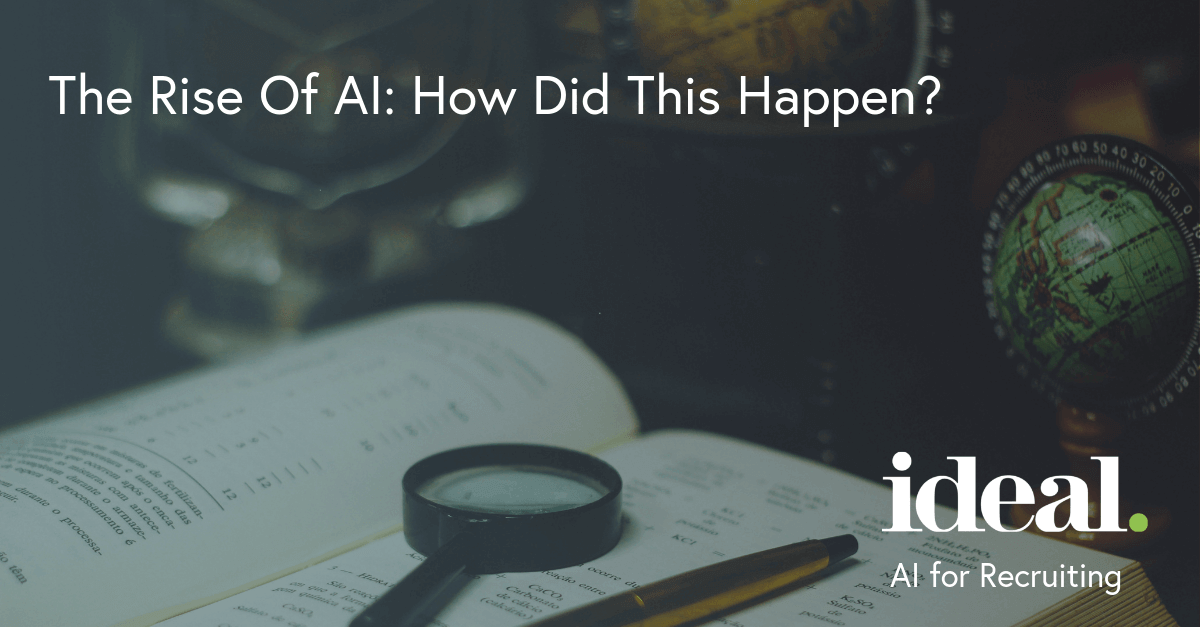
Have you been wondering how the rise of AI began to trend and spread across the globe?
The rise of artificial intelligence
Consider the Industrial Revolution, which lasted somewhere from 60-80 years. Some are calling the current period “The Fourth Industrial Revolution.” Largely expected to be driven by artificial intelligence (AI) and data analysis, this Fourth Industrial Revolution will be compressed into the lifespan of a beagle.
This means absolutely massive changes for how we work and design processes within our work. AI, specifically, is already beginning to have a large impact in recruiting and hiring.
It is helpful now to look at where AI has been, where it’s at now, and where it might be going.
A brief primer on the history of AI
Artificial intelligence actually debuted at a conference at Dartmouth University in 1956. 11 years after the end of WW2, artificial intelligence was on the scene. At the time, there was a lot of optimism. Some people at the conference believed robots and AI machines would be doing the work of humans by the mid-1970s. Of course, that didn’t happen — what happened instead was that funding dried up and a period called “The AI Winter” began. That ostensibly lasted into the 2000s, when IBM’s Watson peaked a lot of interest in artificial intelligence again.
Now we’re at an interesting place. Like PCs in the early 1980s or the Internet in the early 1990s, artificial intelligence is “out there” and people know about it — Tom Cruise and Will Smith movies, for one — but it hasn’t impacted businesses just yet. (Well, not most businesses.) Prominent Silicon Valley executives, like Sam Altman of Y Combinator and Elon Musk of Tesla/RocketX, are beginning to do more around AI — including being scared of its potential ramifications.
The current state of AI
As mentioned above, IBM’s Watson computer is one of the best-known examples of AI in modern business. In October 2016, 60 Minutes profiled how artificial intelligence (in the form of Watson and other platforms) is being used in the healthcare industry. The same show revisited the topic in January 2019 with a focus on emotional and facial recognition.
We’ll get to recruiting in one second, but the healthcare industry is a good starting point to understand where AI is now. For example, an advanced AI platform can access 200 million pages of structured + unstructured content at a given time; that’s four terabytes of disk space. Many have noted that, with the aging of the Baby Boomer generation, the demand for doctors might be 90x higher than supply by 2025. (See how this impacts recruiting?)
AI platforms can drive two essential processes for the healthcare industry, then:
- Have access to an amount of data and patterns (and increasingly see more patterns) than any human being could ever hold at once
- Help hire new doctors at scale
- Help train them at scale
The healthcare industry thus illustrates some of the principles that are driving such quick adoption of AI. For those running companies, it allows for:
- Access to massive amounts of information that can be organized quickly
- Cost-cutting (more on this in one second)
- Scalability
- Efficient data analysis
It’s a win-win-win-win for many organizational leaders, which doesn’t happen often.
AI in recruiting
Predominantly right now, AI applications in the recruiting space are top of funnel, i.e. screening, chatbots for communication, and candidate rediscovery (finding “old gold” in an ATS). Where AI tech is mostly being applied presently is in saving recruiters’ time top-of-funnel so they can spend more time on candidate relationship-building, filling proactive pipelines, better relationships with hiring managers, and the like.
There are lots of theories out there about robots someday doing interviews or other advanced applications of AI and machine learning. Could those happen? Yes. But are they going to happen tomorrow? No.
What will increasingly happen in the AI and machine learning recruiting space is that programs will get better at identifying what exactly makes a candidate qualified for a specific role within a specific organization. As this side of the tech becomes more comprehensive, sourcing and screening will evolve to almost single-click. “Find me the person I need.” So long as that person has a resume/LinkedIn/data entry somewhere, they can be found relative to what the system has learned about the role and the business. That’s going to be the next step in the AI recruiting arc. Don’t worry about a robot doing your interview just yet.
The money side
You can see the bullet points near the beginning of this article regarding cost-cutting and scalability, and these are important talking points for any decision-maker when considering an AI platform for recruiting.
So, will AI cost recruiters their jobs?
Yes and no. In some organizations, recruiters who focus extensively on lesser-value top-of-funnel activities (i.e. more than 60% of their week is spent screening) could lose their jobs as the tech can do it better and doesn’t need a salary and benefits.
By and large, though, AI in recruiting will be used to free up human recruiters to do more value-added work.
The goal is increased efficiency and productivity; you want to be able to slice through mountains of data in a short time, moving essentially from “discovery” to “action.” And you want to do this in a way that benefits your bottom line, which AI increasingly does.
What should you do next?
A checklist includes:
- Learn as much as you can about AI (read, research, watch).
- Consider your business priorities as regards claims investigations relative to cost, productivity, and other metrics.
- Investigate some AI solutions (like us!).
- Compile information on costs, contracts, contract lengths, features, value-adds, and more.
- Organize that information.
- (It would be easier with AI).
- Present to decision-makers regarding course of action.
- Make decisions.
- Execute/enact the decision.
- See the results from improved (and fast) recruiting processes.
